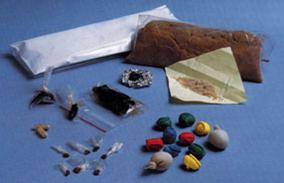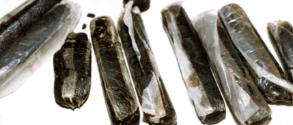Heroin Addiction

Black Tar Heroin
Black tar heroin is a variety of heroin produced primarily in Mexico, but it is similar in appearance and texture to so called Home Bake Heroin from New Zealand. Black tar heroin is the most prevalent form of heroin in the western United States. In the eastern United States, South American-produced "white" (actually beige to off-white) powder heroin is most common. Black tar heroin is also occasionally found in western Canada, though Southeast Asian heroin is the most predominant form there. An interesting fact is that almost all the heroin produced in Mexico is destined for the western United States.
Black tar heroin is the typical street term for the drug, but it has many other street (colloquial) names such as:
-
Pigment

- Negro: the Spanish word for black
- Piedra: the Spanish word for stone
- Chiva: a Spanish word for a young goat
- Nut Job
- "Muck"
- "Slab"
- "Da Black Tah"
- "Nigga Gold"
Mexican drug syndicates were producing heroin by the mid-1960s. Lacking the experience in chemistry that other syndicates had gained through years of illicit heroin production, Mexican organizations used less-refined morphine and also substituted primary chemicals in synthesis. The opium from which heroin is ultimately produced is a golden brown-to-black, gummy latex containing an average of 10% morphine, although morphine content can vary from 3 to 20 percent of content. Pure morphine and heroin are both fine white and odorless powders. In order to produce heroin, morphine is extracted from raw opium and reacted with glacial acetic acid, primarily acetic anhydride for its efficiency. The purity of the final product, and therefore its color and texture, depend on the purity of the source material. Early black tar heroin was notable for its low purity (usually under 30%, at a time when white powdered heroin from the east coast often tested at over 90%), but purity levels have increased dramatically as the producers have gained experience. Accordingly, the price per kilogram of black tar heroin has increased from one-tenth that of South American powder heroin in the mid-1990s to between one-half and three-quarters in 2003.

The effects of black tar heroin are identical to those of powder heroin. Because of the consistency of black tar heroin, it is usually injected or smoked. It can also be ground into powder or dissolved in water and snorted.
Health matters specific to black tar heroin
Users who intravenously inject black tar heroin are at higher risk of venous sclerosis (a condition where the veins narrow and harden, making injection there nearly impossible) than users of powder heroin. Researchers at UC-San Francisco have found that the rapidity with which black tar heroin destroys veins compared to powder heroin (forcing users to inject subcutaneously), along with its gummier consistency (requiring that needles be thoroughly rinsed between use), may put users at lower risk of HIV infection.
Black Tar Heroin is also associated with necrotizing fasciitis (NF). NF is a severe form of cellulitis where infected tissue and muscle rapidly dies and patients can ultimately die of sepsis and kidney failure. Necrotizing Fasciitis has a mortality rate of 20% for treated cases and almost 100% for untreated cases.
Black tar heroin can be associated with Wound Botulism (infection with Clostridium botulinum at the site of heroin injection). Botulism presents as generalized weakness, followed by paralysis of major muscular groups and finally respiratory paralysis. Botulism is treatable with intravenous type An equine antitoxin and mechanical ventilation.
Heroin Information
- Signs of Heroin Use
- Social Effects of Heroin
- Heroin and Health Risks
- Heroin History
- Injecting Heroin
- Smoking Heroin
- Heroin Statistics
- Black Tar Heroin
- Heroin Pictures
